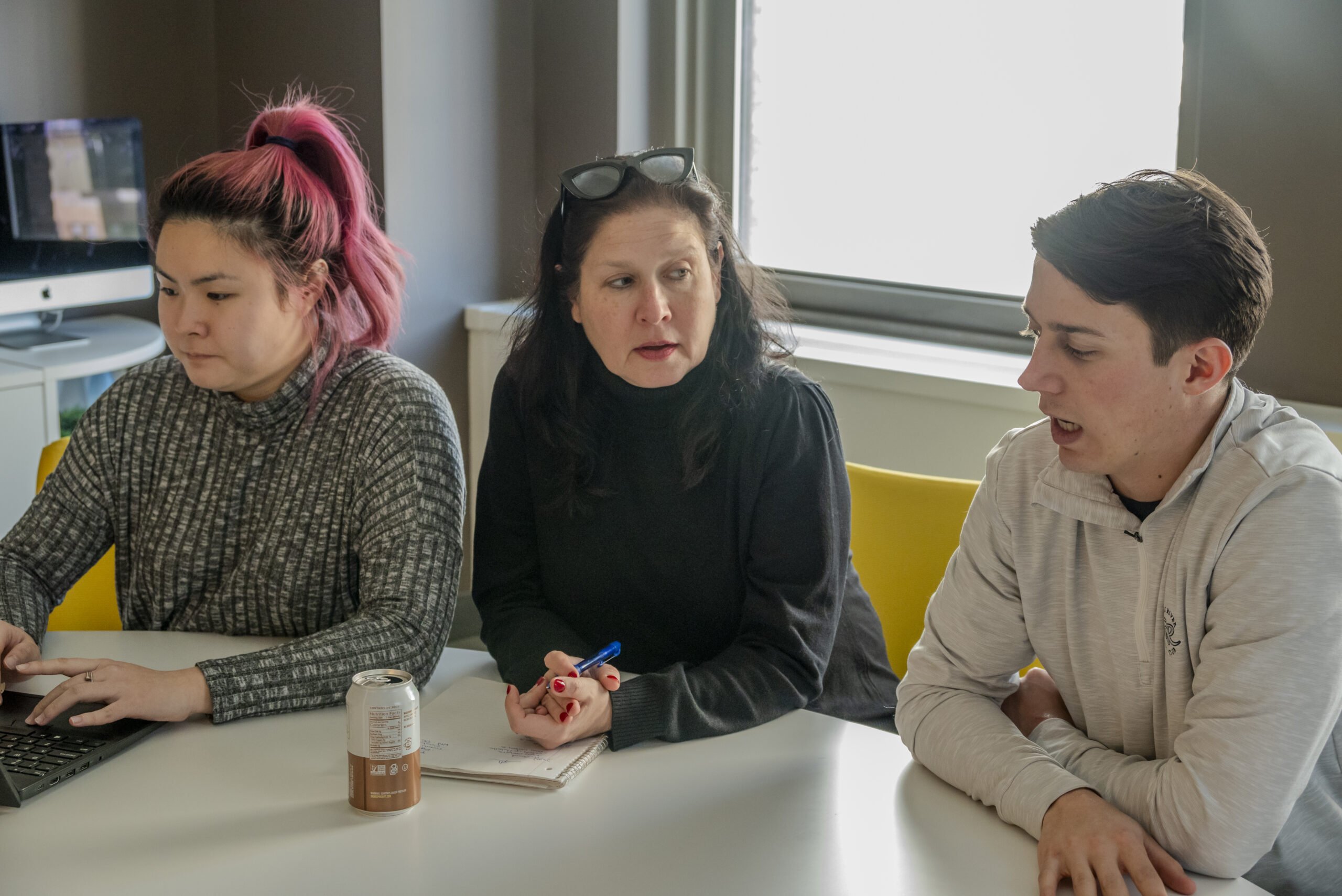As one of the country’s most storied transportation centers, Grand Central Terminal is an iconic New York City landmark that attracts millions of residents and visitors per year. Some people utilize the space as a means to catch a train or bus, while others go there to dine, shop and take in the picturesque surroundings. The team at Direct Results works in close proximity to the station, providing a facile means of access when they work in-person and are able to collaborate with one another. Media buying, per se, is a niche of the industry that requires preparation, nuance and dedication to the craft.
A quick elevator several floors up the building brings you to the Direct Results offices with a view of the facade of Grand Central Station with the shadows of the “Big Apple” in its background. Although there are not as many people in the building on this particular day, there is still plenty of communication between the team, which is dispersed all across the United States. Company president Jill Albert is involved in key decisions pertaining to accounts and other ventures, frequently collaborating with her colleagues and assisting with a variety of tasks. Since the business was established in 2007, it has achieved 495 successful campaigns creating $11.3 billion in sales.
While each of the media buyers and supervisors have specific focuses regarding accounts, potential future ventures and management, there is a palpable synergy that is evinced within their processes. Much of the day contains conversations and collaboration to ensure that the company is in a position to effectuate and execute business deals and related campaigns. As the associate media director of the firm, Linda Salzberg is responsible for overseeing the tasks of the media buyers while also working on her own accounts, serving as an integral professional in the aggregate operation.
“It’s really all about the partnership,” Salzberg said. “The idea is that we have with each other; the idea is that we have between the clients and what we hear back from the reps, so we try to not overschedule ourselves. We do have one day of the week where it’s pretty much a no-meeting day for everybody to catch up on paperwork. I definitely meet with a lot of people within our team because I’m training and working with everyone.”
Direct Results began the day of meetings by engaging with a sports radio station to discuss its advertising. The conversation commenced surrounding a discussion about a client and its second-quarter plans. In essence, Direct Results is serving as somewhat of an intermediary between media outlets and different clients, operating from an allocated budget with the expectation of delivering results. The company enjoys overdelivering for its clientele and works to build and maintain strong relationships leading to a favorable return on investment. Because of the intricacies and multifaceted nature of the job, however, there is ambiguity and a deluge of misconceptions surrounding what goes into the work itself.
“A lot of people just ask, ‘What is that? Buying air-time?,’ but I don’t think people realize the hard work and all of the different parts of the job that there are,” Salzberg said. “They might think that you just sit at a computer and put spots and dots and numbers and costs into a chart, and then you just make your decision, but it’s really about putting together strategic recommendations for the client and using your creativity and communication skills and resources to do your job.”
While conversing with the sales manager at the sports radio station, Direct Results staff asked about the trajectory of the client moving into the second fiscal quarter. This outlet wants to push their spend later in the year, specifically in the third quarter, but was curious if they should put together a proposal for the second quarter. In response, media buyer John Vitti informed the professional that holidays and sports sponsorships are good to have and could potentially move the needle. Direct Results is receptive to new business ideas, utilizing an advertising budget to purchase time to run messages on stations throughout the country.



The work pattern for the day changed when discovering a potential new business opportunity that they needed to assess by the next morning. This required determination and a willingness to commit time and focus to the craft. For Direct Results, the occurrence is not anything new and a means by which to benefit from a dynamic marketplace.
“We will never turn down a quick turnaround,” Vitti said. “We might say, ‘We might need a little bit more time,’ but we had things come in today that people want to hear back [on] right away, [and] we don’t just drop everything to do stuff because our other business is important, but we love new business and we love to come up with new and creative ideas and be bold.”
Later in the day, Vitti took a call with a sales representative from the same geographic area simply to catch up about non-work activities and investing time into learning more about its staff. While Vitti has only been in the role for three years, he has already created strong relationships and subsequent loyalty where he always checks with certain outlets in the area with opportunities he may have.
“Just doing calls once in a while [and] reaching out, even if it’s just checking in about, ‘Hey, how did your kid do at his hockey game?,’ or, ‘Heard it was your birthday last week. Hope you had a great week,’” Vitti outlined. “Doing things like that goes a long way to keep your partnership and work but also maintain a friendship level as well.”
Before working as a buyer concentrated in the audio format, Vitti questioned the viability of the radio medium as a whole. In essence, he was wondering whether people listen to the medium at all, a suspicion to which he quickly received an answer upon assimilating into the space. Through his work in the space, he has discovered that local radio and audio are among the highest advertising mediums. The outlet has thus been able to leverage purchasing power and discretionary income to drive profits and benefit its bottom line.
“[In] local radio buying, people can come up to you and say, ‘Why would we do that when you can be on other things,’” Vitti divulged. “Well it does work, and it has proven to be successful.”
During the course of the day, Salzberg and Vitti scrutinize stratified ratings data from Nielsen Media Research that provides quantitative information to guide their decision-making process. The software they utilize automatically loads the latest ratings data from across the country and allows them to create customized alignments to measure and compare data points.
Moreover, they look at accurate cost per thousand metrics (CPMs) and reach data while also receiving weekly post-logs to ensure the advertising spots ran at the appropriate times. The first step in evaluating a potential client is in comprehensive research to approach the managerial process with a bonafide strategy based on enumerated results.
“We have to understand our goals, what’s worked in the past, what hasn’t [and] why – then we pull all kinds of data,” Salzberg said. “We have a proprietary system here for Direct Results clients where we can look up CPLs by category so we can see which the highest performing stations are, [so] we just have a ton of historical [data] that just helps inform us.”
Although these quantitative results are an indispensable aspect of the paradigm, the company values qualitative observations based on accrued experience and expertise. These empirical measurements are usually not represented by a number or mathematical variable; rather, they are based on examining perceptions and prognosticating onto their future potential. For example, Salzberg and Vitti listened to several demos of on-air talent performing an advertising read for a client and shared their opinions in real time. They were ultimately trying to determine which person was the best fit for the company, along with their overall attitude to represent the brand with enthusiasm and alacrity.



Throughout the day, Direct Results was trying to gather both of these data to determine whether investing their clients with different brands across marketplaces was beneficial. Spreadsheets and pivot tables allow for data to be more effectively synthesized with aspects of comparative analysis and other schema. One of Salzberg’s meetings during the day was with Kirsten Tannen, an account manager with the brand who breaks down the data and tries to make shrewd, informed recommendations. She is involved in the process throughout preparing and accomplishing a buy, which is ultimately indicative of a resolution with the groundwork completed by Direct Results.
“It’s really like pieces of a puzzle making sure that everything makes sense from [us] looking at the right targetability [and] we’re looking at the right pricing information,” Salzberg said. “It’s a small piece – we’re not ranker buyers or the lowest-cost stations. It really has to make sense, and then we work with the stations to make them work.”
The process does not end once the buy is compiled, immediately moving to optimization to make sure that the enterprise proves to be successful. Direct Results consistently checks logs, reviews content and makes suggestions throughout. There are occasions where advertising does not air as scheduled, something that is usually quickly solved with an apology, a rerun of the missed spots along with bonus spots at the station’s discretion. Aside from reviewing data and making decisions on how to spend a budget, there are elements of other areas of media in the job that engender ingenuity and imagination.
“There’s so much content out there,” Salzberg said. “There are a lot of charts which may scare a lot of assistants when they get started, but it’s so much more than that. There is so much creativity. We also help write the copy, so especially now with programmatic buying being as big as it is, there are just certain things that can’t replace humans.”
Direct Results holds a weekly buyer status call to review the status of existing properties and strategize on how to approach future endeavors. In addition to the staff based in New York, buyers Martin Mihaly and Pearl Kim appear through teleconferencing software to contribute to the conversation. Mihaly and Kim are part of other discussions throughout the day as well outside of the regularly-scheduled meeting, firmly embedded in the systematic functionality of the firm. The company utilizes the Google Suite of platforms to communicate, meet and organize data, invariably facilitating rapport and synchronous conversation.
While various studies demonstrate that audio remains a powerful medium, it is competing with many other sources of content amid dwindling attention spans. Consumers ostensibly possess more choice than ever before to determine which content is worthy of their mindshare, leading brands to prioritize enthralling and dynamic content to satisfy this appetite.
Industry professionals frequently cite the conversational nature and intimacy of radio as an inherent advantage for the platform. At the same time though, stations have made the transition to implement visual elements to their programs, providing another means of interaction and engagement. Furthermore, consumers can stream audio using the internet and take part in the show through platforms such as social media applications and text lines.
“We have ways of finding them, so it’s really just transferring channels,” Salzberg expressed. “There are still listeners who listen on the old channels. It just gives you opportunities to overlay traditional radio with all kinds of extensions that we didn’t really have the opportunity to do before.”



ESPN New York will leave 98.7 FM on Aug. 31 of this year, declining to renew the frequency lease from Emmis Communications. The decision was made by Good Karma Brands, which operates ESPN New York under a local marketing agreement and owns the WEPN 1050 AM frequency as well. Data corroborating the decision, as revealed by founder and chief executive officer Craig Karmazin to the New York Post, was that 60% of listenership for the outlet takes place outside of radio. Additionally, within the 40% cohort of those who listen on traditional radio, eight out of 10 consumers are anticipated to be able to find the station on AM.
“I know that is in New York, which is the top market, so yeah, it’s definitely telling, but I do think ultimately we’re all going to evolve and pivot towards whatever it’s going to be, but I don’t know that it’s going to happen overnight,” Salzberg said. “We do so much with all size markets and small markets, and we’re doing a lot of emergency programming for smaller markets.”
Another meeting during the day with a sports radio brand is held to review the status of a campaign being carried out for a client. Following brief discourse about NFL free agency, the topic moved to potentially holding a Father’s Day campaign. Brainstorming in the meeting cultivates an idea that will implement talent and the client’s chief executive officer, something that will aim to heighten awareness and ultimately move the product.
Despite the momentum behind a buy often following a similar archetype, there are permutations in the final result. With a staff containing several different media buyers and other executives, institutional aptitude and accompanying input helps lead to a final result. The path to attain prosperity may be different, but Direct Results maintains a collective focus on benefitting both their clients and stations through a mutually beneficial partnership.
“There’s no right way to do a buy,” Salzberg said. “The three of us could do three completely different buys, and they might not all engage, but they could all look good on paper. What we really try to do is take all of the steps and put it together like a puzzle.”
As the sun begins to set over the New York metropolitan area, the staff at Direct Results continues to remain ready to help clients, meet with colleagues and look ahead to the future. Salzberg herself works late into the evening, finishing her managerial tasks before reviewing her active buys and considering new opportunities. She usually commutes into the office several days per week in addition to her other clients, a hybrid work structure that has worked well since its adoption.
In the end, Direct Results wants to gather optimal results for the clients and stations as the authority in audio advertising. The company is fueled by its current undertakings while remaining intrigued by possibilities in the modifications being made to content creation, dissemination and promulgation. Direct Results is looking to ensure the viability and long-term success of the audio medium, exhibiting a fervent zeal and steadfast commitment to generate remunerative and rewarding results. This is ultimately achieved through substantive, preeminent partnerships with an enduring impact that conveys the comprehension of nuances and esoterica within the evolution and efficacy of audio, along with the passion for the craft.
“You’re not just buying time; you’re really engaging customers in a really fun way, and with radio [and] audio, people are really loyal to their talent and they really trust them,” Salzberg said. “When it fits, it’s like a no-brainer.”
Derek Futterman is an associate editor and sports media reporter for Barrett Media. Additionally, he has worked in a broad array of roles in multimedia production – including on live game broadcasts and audiovisual platforms – and in digital content development and management. He previously interned for Paramount within Showtime Networks, wrote for the Long Island Herald and served as lead sports producer at NY2C. To get in touch, email Derek@BarrettMedia.com or find him on X @derekfutterman.



